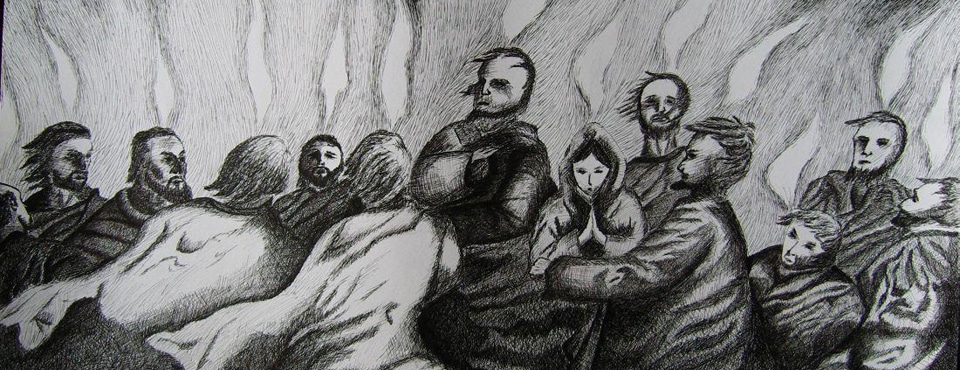
In Defining Church (part 3) I concluded, “When defining church we must start with God’s people in God’s presence and we must recognize that the first century Jewish person would have recognized that this happens most clearly and powerfully when God’s people are assembled.” Almost all of what lead to this conclusion in my first three posts in this series came through passages of Scripture in the Old Testament. In fact, much of the basis of the above conclusion has been based on things that happened thousands of years before the church came into existence. [bra_highlight style=’highlight1′]This begs the question, does the New Testament support the idea that at the heart of “church” is God’s people gathered together in God’s presence? The answer to this is a resounding “Yes.”[/bra_highlight]
Shavuot and Pentecost
Shavuot is a God ordained holiday commenced to celebrate the first fruits of the harvest (Exodus 34:22 & Deuteronomy 16:10). This holiday is also known as The Festival of Weeks because it was to be celebrated seven weeks (and one day) after the celebration of Passover. Overtime though, the celebration of Shavuot became begin to be less about the celebration of the first fruits of the harvest and more about commemorating the day God gave Israel the Torah – the day the Israelites referred to as “The Day of the Assembly” because God had given them his presence as they assembled. Giving this meaning to the holiday was logical because it was believed the Israelites were wandering in the desert for 50 days before God met them at Mount Sinai and because it was easy to symbolically connect the giving of the Torah with God’s provision in the harvest.
Fast forward to the time of the New Testament narrative. Jesus dies on Passover as the Passover Lamb. While the theological significance of this is beyond the scope of this post, let me just say that the Gospels go to lengths to make this truth obivious. 1 Corinthians 5:7 states it most clearly, “For Christ, our Passover lamb, has been sacrificed” (NIV).1
Jesus was later resurrected and he spent time on earth teaching his disciples. In Acts 1:4 we read, “On one occasion, while he was eating with them, he gave them this command: “Do not leave Jerusalem, but wait for the gift my Father promised, which you have heard me speak about.” After this, Jesus was taken into Heaven and the disciples are left waiting for the promised gift which we know to be the coming of the Holy Spirit.
Before we turn our attention to the story of the Holy Spirit’s coming in Acts 2, there are three more important things I must mention. First, through the thousands of years between God’s coming at Mount Sinai and the life of Jesus, traditions had developed about the events surrounding the Israelites experience at Mount Sinai. Two of these traditions are very important: 1) It was believed that when God spoke the law out of the fire on Mount Sinai that his voice was actually visible in the fire. In other words, it wasn’t only that God was visible in the fire and he spoke, but the people could literally see God’s voice through the fire. 2) It was believed that when God spoke the law to the Israelites on Mount Sinai that it went out in the language of all surrounding people so that they had the right to choose God’s law.
The second thing I must mention before we turn our attention to Acts 2 is that during the time of the New Testament, the Israelite people were living under Roman rule and many had become Hellenized. Thus, the holiday Shavuot was given a second name, Pentecost (This means “fifty” and refers to the holiday being 50 days after Passover as did the title “Festival of Weeks”).
Shavuot was given a second name, Pentecost.
Thirdly, the day the Holy Spirit came was the beginning of the church. If you were to read beyond the first four verses of Acts 2 you would find that Peter addresses a crowd of people who witness the commotion, thousands of people accept the Gospel message, and those who accept the Gospel become the first church as they “devoted themselves to the apostles’ teaching and to fellowship, to the breaking of bread and to prayer.”
Acts 2:1-4 says, “When the day of Pentecost came, they were all together in one place. Suddenly a sound like the blowing of a violent wind came from heaven and filled the whole house where they were sitting. They saw what seemed to be tongues of fire that separated and came to rest on each of them. All of them were filled with the Holy Spirit and began to speak in other tongues as the Spirit enabled them.” Five things to notice:
1. This happens on Pentecost or Shavuot, the very day the people are celebrating God’s presence coming to his people as they assembled around Mount Sinai.
2. The disciples were “all together in one place.” God’s people were assembled.
3. Most would agree that “a sound like the blowing of a violent wind” is meant to remind readers of the “trumpet blast” that proceeded God speaking in Exodus 19:16.
4. People seeing tongues of fire vividly reminds readers of the tradition of God’s voice being visible in fire on Mount Sinai.
5. People speaking in different languages brings to the readers mind the tradition that God’s law went out in the language of the surrounding peoples at Mount Sinai.
With these things in mind it is hard to miss that God was, in some way, reenacting the events of Mount Sinai. Why? God wanted to show from its inception that church is, his people gathered in his presence. This truth continues to be taught in the New Testament. In the next blog post I will present and expound on some of these verses.
Continue to Defining Church (part 5)
1. All Scripture is NIV.

Pingback: Defining Church (part 5) - Creekside Bible Church
Pingback: A Rant on Technical Difficulties at Church
Pingback: Music 5/19/13 - Creekside Bible Church
Pingback: Children in Church (part 4) - Creekside Bible Church
Pingback: Defining Church (part 6) - Creekside Bible Church
Pingback: Defining Church (part 3) - Creekside Bible Church
Pingback: The Church My Mother - Creekside Bible Church
Pingback: The Doctrine of Resurrection (Part 1) - Creekside Bible Church